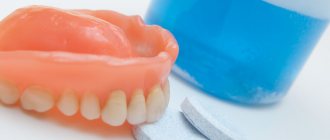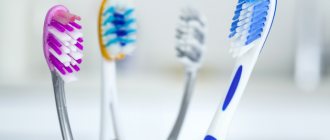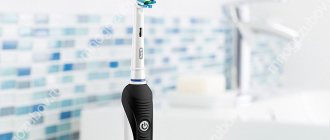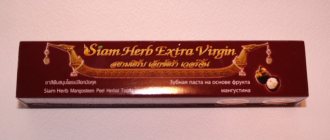Removable and fixed dentures require daily cleaning and regular care, just like teeth. Ordinary toothbrushes with soft bristles are also suitable for cleaning the product, but it is preferable to use special brushes designed for dentures, dental structures, braces and professional care for them. Denture hygiene includes mechanical and chemical cleaning. Mechanical cleaning is performed using toothbrushes with soft bristles for gentle care of dentures, braces, and gums. For cleaning, you can also use dental floss, a single-row interdental brush-brush that penetrates hard-to-reach places.
Types of brushes for dentures - the best brands, cleaning features, prices
Article navigation
- Special brush for dentures
- Peculiarities
- Types of brushes
- How to use
- Rating and cost of popular models
- Features of storage and care
- Alternatives
Question for a specialist
We are all used to brushing our teeth in the morning and evening with a toothbrush. Some people use soft, some medium, and some prefer hard for cleaning. But people with orthopedic structures in their mouths need a special brush for dentures. And not only for removable ones - for non-removable ones too, so that the new teeth last as long as possible and delight the eye with high aesthetics. Next, we will talk about what a toothbrush for dentures should be like, how to use it correctly, and what types of regular ones can be used for cleaning.
Grinding process
Sanding can be done by hand, but most often it is done using a sander with sandpaper holders. During mechanical grinding, the specialist must be as careful as possible so as not to damage the structure.
After the procedure, the surface of the prosthesis should be smooth, with rounded edges, without defects or roughness.
First, the specialist uses a coarser sanding cloth (with large abrasive grains), and completes the sanding with the thinnest cloth.
The processing is carried out using a grinding motor or drill , cutting the paper into strips and inserting one side into the hole of the grinding motor tip or into the paper holder.
Only the outer surface of the base is sanded until a smooth, even surface without flaws is formed. Clasps and other metal structural elements are also polished .
It is necessary to carefully grind the ends of the clasps so that they are rounded and smooth.
Clasps made of noble materials are thinned with very fine-grained sandpaper, which is even called velvet. Only the inner surface of the base and artificial teeth cannot be polished.
Do you need a special brush for dentures and why?
According to orthopedic dentists, a toothbrush for cleaning dentures, especially for removable ones, should be separate and have special characteristics. In essence, a denture is an imitation (even a very good one) of natural teeth. And if people know how to brush their own teeth, then with artificial ones they can get the misleading impression that they do not need cleaning, but only, for example, rinsing with water or soaking overnight.
But artificial materials - acrylic (plastic), nylon, ceramics, composite and even metal - can become damaged over time. For example, from hard pieces of food or sour foods. As a result, soft food deposits settle in the cracks formed, as well as harmful microbes. As for plastic, its surface has tiny pores in which plaque and dyes (from food, drinks or tobacco) are retained even without external aggressive factors. Ceramic and composite materials can be painted. Another nuance is that the denture follows the shape of the teeth and gums, i.e. has small tubercles and depressions in which plaque also settles.
Useful video
From this video you will learn how to clean dentures at home:
As a result of improper care, dentures can lose their aesthetics and become deformed. Over time, such products may become unusable.
In addition, poor cleaning of the structure can lead to the formation of ulcers on the mucous membrane, changes in taste sensations and inflammation of the gums.
To avoid unpleasant consequences, it is important to regularly clean the prosthesis. To do this, you need to use not only a toothbrush, but also high-quality toothpaste .
Features of Cleaning Tools
A toothbrush for both removable and fixed dentures must have the following qualities:
- high-quality bristles: as a rule, this is synthetic bristles - natural bristles tend to become moldy if poorly washed and dried. Each bristle is rounded at the end to avoid scratching artificial materials,
- thick bristles: to remove large amounts of plaque in a few strokes,
- the bristles are arranged in a special order: it can be a zigzag, a wedge, a bunch - to clean hard-to-reach places,
- comfortable brush handle: as a rule, it is small for removable dentures, which are cleaned by removing them from the mouth. For non-removable ones, it is more convenient to use a tool with a standard length handle. Also, the handle should be ergonomic and not slip in the hand.
Don't know what type of prosthetics to choose?
We will help in the selection, advise where to read more information and compare types of prosthetics.
Consultation with an orthopedic doctor in Moscow clinics is free! Call now or request a call
Working hours: from 9:00 to 21:00 - seven days a week
“We recently gave our granny a special brush for her dentures. It is different from the usual one. The bristles are longer and there seem to be more of them, and on the back there is a tuft of bristles. Grandma says that it’s convenient to use, the handle doesn’t slip and cleans well in all places.”
Tatyana_93, review from otzovik.com
Types of hygiene instruments
Specialized brushes for cleaning dentures differ in the location of the bristles, their shape, the length of the bristles and handles, direction, and bend. The following classification of hand tools can be distinguished:
- double-sided (most popular): The bristles are on both sides of the head of a denture toothbrush. For example, on the one hand it can be a tuft or wedge-shaped arrangement of villi, on the other hand it can be flat or zigzag bristles. The handle is shortened, slightly curved for convenience,
- one-sided: similar to a regular brush for oral hygiene, because The bristles are located on one side only - they can be zigzag-shaped or flat. As a rule, the handle of such a tool is short,
- monotuft: the head contains a thin tuft of rounded bristles and has a thin handle.
These tools can be used to clean not only orthopedic structures, i.e. prostheses, but also orthodontic ones - braces, plates, aligners, mouth guards (for example, whitening and for people with bruxism), as well as sports mouth guards. Miniature tools – brushes – can also be used for cleaning. They consist of a short handle and a vertical wire, which is entwined with bristles. Brushes are used for cleaning between crowns, bridges, clasps, restorations on implants and natural teeth.
%akc61%
The bristles of a toothbrush for cleaning dentures can be soft - this is exactly the modification most manufacturers offer, as well as ultra-soft and medium hard. The dentist will tell you which one is better to choose after assessing the condition of the teeth, gums and its relationship with the materials used for prosthetics.
Kinds
Many manufacturers of dental devices produce several types of brushes for cleaning dental structures .
Therefore, consumers with installed structures have the opportunity to purchase the most suitable device.
It should make the hygiene procedure easy and quick.
Note! On the modern market there are such devices as:
- Device for cleaning the prosthesis . It is a mechanical device with a comfortable long handle and an oval-shaped head. The main difference of the device is the presence of fibers on both sides of the working head. It adapts to the characteristics of the gum lines and the surface of natural or artificial teeth. The product delicately cleans orthodontic structures without leaving micro-scratches.
- Mono-beam brush. It consists of a thin handle and a cleaning head with soft synthetic or natural bristles collected in one bundle. The working part of the device has a round shape with smoothed edges and is small in size. The device is used for cleaning fixed dentures, individual elements of removable structures and hard-to-reach areas that cannot be cleaned with a conventional device.
- Interdental brush-brush . In appearance, the device is similar to a household brush for washing various containers, but is smaller in size. The device consists of a small, comfortable handle and a rod with synthetic bristles attached to a wire base. A brush should be used with installed bridges and plate prostheses.
Electric toothbrushes are not used to clean orthodontic structures.
After all, such devices are capable of creating vibrations in fixed structures or elements of removable installations.
And this increases the likelihood of breakdown.
How to use it correctly
Using a toothbrush for dentures is not difficult - you can learn this simple technique in just 1 brushing. By the way, the orthopedist himself can tell you how to clean it correctly, but some doctors miss this point. Therefore, further we will talk about the nuances of oral hygiene with fixed and removable orthopedic structures.
Cleaning fixed dentures
Here, the technique and regularity of brushing is not much different from caring for your own teeth. First, wet the brush, apply 1 pea of special paste to the bristles, then distribute it evenly over the surface of the denture. Crowns, bridges and fixed implant structures are cleaned using sweeping movements from the gums to the cutting crown. The chewing surface of the crowns is cleaned using back and forth movements. Additionally, you can massage your gums in a circular motion for 15-20 seconds - this will maintain their tone. Then you need to rinse your mouth twice.
Interesting to know! This method is suitable not only for fixed, but also for some removable orthopedic structures that do not need to be removed from the mouth every day - these are clasp and conditionally removable on implants.
%akc52%
Cleaning removable dentures
Removable structures are cleaned outside the oral cavity (even after each meal, but at least 2 times a day - morning and evening). To do this, they are first removed from the mouth or from a special box and washed well in water. Then, as in the previous point, the paste is squeezed onto a brush moistened with water, and the substance is distributed over the surface from all sides - outside and inside, under the artificial gum. Next, clean the denture thoroughly using circular movements, but without strong pressure. Depending on the length of the structure, cleaning may take 3-10 minutes. Next, the product is washed with clean water and dried if necessary. Then you can apply a fixing cream to it and install it in the oral cavity.
A similar cleaning method can be carried out after weekly disinfection of the prosthesis in a special solution. After soaking, the structure is cleaned in the same way, but without using toothpaste.
Basic storage rules
Grandparents can tell you that previously the “jaw” should have been placed overnight in a mug or glass of clean, cold water. It's all about the materials used in production. The rubber contained in the composition needed to be protected by a moist environment from cracking and drying out, as a result of which it became excessively fragile.
Innovative modern options no longer require such manipulations. The main place in which it is recommended to save them is the mouth itself, and not anything else. Silicone, acrylic, nylon and other materials do not require storage in liquid. You can purchase a special container that prevents dirt and dust from settling on the surface, but a clean cotton handkerchief or a piece of gauze folded several times will also work. However, it is best to consult with a doctor at the Dentika clinic, who will give clear and competent instructions on how to properly treat different materials.
Rating and cost of popular models
Double-sided Curadent model from Curaprox
Double-sided instrument with ergonomic handle for removable orthopedic structures. On one side of Curadent (“Curadent” from “Curaprox”) there is dense, flat-shaped bristles, on the other there is a spiral-shaped brush for hard-to-reach areas. The cost is about 1400 rubles. The instrument can be replaced with the classic soft Curaprox “soft”/”ultrasoft” or supplemented with the monobeam Curaprox cs1006 “single & sulcular”.
Double-sided model Paro Prothesen
Double-sided Paro Prothesen is a combination of flat bristles and a tuft of bristles located on different sides of the head. The five-layer bristles include hard and soft bristles for thorough cleansing. The manufacturer recommends cleaning carefully, without bending the hooks (clasps) and clasps (attachments) of the orthopedic design. The average price of a product is 350 rubles.
Double-sided model Protho Brush De Luxe from Miradent
Protho brush de luxe is designed specifically for patients with poor hand motor skills. The octagonal handle of a special ergonomic shape fits comfortably in the hand. This allows you to efficiently clean the prosthetic structure from all sides, even with weak and not very precise movements. The average price is 320 rubles.
Double-sided Denture Brush model from Y-Kelin
The miniature Denture Brush from Y-Kelin (about 10 cm long) is convenient for both home use and travel. The double-sided head with medium-hard bristles effectively cleans hard-to-reach areas. The instrument is safe for the body, because Made from high quality food grade plastic. Cost – 280 rubles.
Bilateral model Pro-Expert Clinic Line from Oral-B
The Pro-Expert Clinic Line double-sided brush for dentures has flat bristles on one side of the head and wedge-shaped bristles on the other for cleaning hard-to-reach areas. Consists of synthetic materials. Also suitable for cleaning orthodontic appliances. The average price is 270 rubles.
Bilateral PresiDENT Denture
PresiDENT Denture contains 2 types of bristles of varying degrees of stiffness. Short pile is intended for cleaning the surface of orthopedic structures. Long pile is intended for “secluded” or hard-to-reach areas. The average cost is 270 rubles.
SILCAMED set (paste + double-sided brush)
The SILCAMED set consists of a soft double-sided brush with a comfortable handle and gel paste. On one side of the head of the instrument there is a small tuft of bristles; on the other side the bristles are flat and thick. The cost of the set is about 250 rubles.
Double-sided Protheses from Fuchs
The Fuchs Protheses brush is also double-sided and has 2 types of bristles. Angled bristles - with the help of which hard-to-reach areas and recesses are cleaned. Straight and long are designed to care for the rest of the surface - removing food plaque and bacterial film. The average price is 160 rubles.
Single-sided Denture model from TePe
Denture polyamide bristles from TePe are created in such a way that dangerous microbes and food deposits do not linger on it (of course, after washing the instrument). The manufacturer notes that the brush is easy to use, the shape of the bristles is maintained for a long time, which allows for high-quality cleaning of the prosthetic structure for a long time. The cost is about 280 rubles.
Single-sided Prosthesis model from Pierrot
Pierrot Prosthesis is single-sided, but contains a large number of flexible bristles with a straight outline. Effectively and carefully cleans the structure from dirt, i.e. preserves the original appearance of the product and prevents dental diseases. Suitable for orthodontic appliances. The average cost is 230 rubles.
Necessity of processing
Sometimes microcracks form on the surface of the prosthesis, which leads to the accumulation of bacteria.
Polishing and grinding the prosthesis will help get rid of microcracks, uneven surfaces and other defects. They are safe and easy to perform procedures.
Sanding is necessary to remove excess plastic or plaster from the edges of the denture. In this way, it is possible to achieve full compliance of the product in shape and thickness with the previously modeled wax cast.
After grinding, the surface becomes slightly rough, which helps food debris stick to it and cause bacteria to multiply.
Polishing helps create a perfectly smooth surface of the denture. Thanks to this, it becomes more durable, resistant to physical and chemical influences, and acquires a beautiful aesthetic appearance. Also, after this procedure, caring for the artificial structure is greatly simplified.
Processing of the prosthesis is performed in a certain sequence:
- removing plastic residues, eliminating irregularities along the edges of the product;
- finishing of the external surface, control of base thickness;
- finishing of the distal border of the product;
- finishing the edges adjacent to the teeth;
- finishing the area near the clasp;
- finishing near the necks of artificial jaws;
- finishing the inner surface of the product (carefully eliminating minor defects with smooth, sliding movements of the devices).
Features of storage and care
Before first use, be sure to wash your denture toothbrush with soap and running water, and always rinse it after use. The tool should be stored vertically, with the bristles facing up, so that water can flow freely from the bristles. The cup or storage clips should be open or well ventilated. You can store the product in a special box with a built-in bactericidal lamp. Once a week, it is recommended to soak the instrument in a disinfectant solution or in mouth rinse for about 10-15 minutes. Do not forget that you need to change the brush to a new one every 2-3 months and after each illness.
Read on the topic: how to properly care for “old” and “new” teeth after dentures - useful recommendations in one article.
Are there alternatives to brushes?
At home, you can replace the brush for cleaning dentures with a classic or children's brush - but they must have soft or ultra-soft bristles. But the answer to the question whether it is possible to clean dentures with an electric brush will be negative. After all, such a tool creates high-frequency vibrations, which can damage the structure or its fixation to the teeth.
As an addition to daily care, you can purchase an irrigator. This device is designed to thoroughly wash away food debris and cleanse the subprosthetic space. For preventive purposes, it is recommended to undergo a medical examination with your orthopedic dentist 2 times a year. The doctor will examine the oral cavity for diseases and the prosthetic structure to identify breakages and hard deposits on the surface. The latter are formed due to poor oral hygiene and cannot be removed independently. But clinics have special equipment for professional1 cleaning, after which the prosthesis looks like new.
Nuances of choice
- Thorough cleaning of the tooth surface is possible with a sufficient length of the working part - 2-2.5 cm. This size is designed to capture several teeth at the same time.
- The head of the brush should be rounded so as not to injure the mucous membrane. The unevenness of the outer part provides additional hygiene.
- The movable junction between the head and the handle puts moderate pressure on the crowns and gums.
- The handle with rubber inserts makes the brush more comfortable to use and prevents it from slipping in your hands.
Need to consider:
- Ultrasonic and ionic models greatly facilitate care, but are less accessible due to their high cost.
- Electric ones effectively cope with the function of cleaning teeth. Do not use for gum diseases or unhealed sutures.
- Manual ones are cheaper than others, but are effective only if the correct movements are performed.
User Questions
QUESTION Hello, there are stains on my removable denture that cannot be cleaned with a denture brush. I tried the regular one, it doesn’t help either. Maybe I need to clean it with a stiff brush or buy a special whitening paste? Evgeniy V.
ANSWER Hello, Evgeniy. You should not “torture” your dentures with hard brushes, whitening pastes with aggressive substances or abrasives. This way it will quickly lose its appearance and may even break. If difficult-to-remove stains, plaque, or growths appear on the orthopedic structure, then the best option is to take the prosthesis to the dentist, where there is special equipment for professional cleaning. Such a service costs very little, but its effect is preserved as long as possible.
1Nikolaev A.I., Tsepilov L.M. Professional and individual oral hygiene in adults, 2022.
Author: Chernov A. R. (Thank you for your help in writing the article and the information provided)










